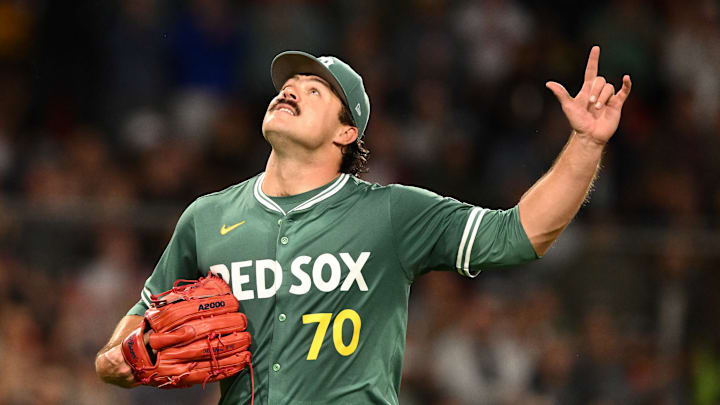Two of the most promising young pitchers in baseball made their big-league debuts on Friday. The Boston Red Sox called up No. 28 prospect Payton Tolle to face Paul Skenes and the Pittsburgh Pirates at Fenway Park. The New York Mets welcomed the rival Miami Marlins to Queens with Jonah Tong, MLB's No. 44 prospect, on the mound.
Both put together excellent debut performances. Tolle went 5.1 innings and allowed two earned runs on three hits and two walks with eight strikeouts. Tong went five innings even, allowing just one run on six hits and zero walks with six strikeouts. Each pitcher excelled in his own unique way. But who put together the "better" MLB debut?
That is an impossible question to answer with any real objectivity. We all have different preferences and standings for evaluating a pitcher's performance. On the surface, Tong (1.80 ERA, 1.20 WHIP) appears to edge out Tolle (3.38 ERA, 0.94 WHIP). If we want to go by the most basic of statistical measures, Tong allowed less damage. He even faced a (marginally better) offense in Miami, although Pittsburgh has steadily improved since its early-season slump under ex-manager Derek Shelton.
But this debate deserves a more in-depth analysis of each performance — and perhaps a bit of data extrapolation to determine which pitcher might perform better down the stretch and maintain his excellence into October. It's way too early for any definitive takeaways on either pitcher, of course, but we can at least dig into the numbers a bit.
For more news and rumors, check out MLB Insider Robert Murray’s work on The Baseball Insiders podcast, subscribe to The Moonshot, our weekly MLB newsletter, and join the discord to get the inside scoop during the MLB season.
Payton Tolle kept the Pirates on ice
Tolle pitched five pristine innings for the Red Sox. Pittsburgh finally drew blood in the sixth, however, as Tolle left with runners on first and second with one out. Greg Weissert came in and promptly blew Boston's 2-0 lead, which left a slight stain on an otherwise joyous night for Tolle and the entire Red Sox organization.
Here are the simple facts. While Tolle was responsible for more runs than Tong, he also went (a little bit) deeper into the game. Tong was pitching a blowout in New York; Tolle cultivated a slim lead against Paul Skenes, which Boston promptly gave up (and never regained) as soon as he left the game.
Tolle allowed fewer hits and base runners in general. On 84 pitches, the Pirates put 11 balls in play. That's an impressive 13 percent. Tolle forced 14 whiffs and hammered the zone on 55 percent of his pitches, compared to seven whiffs (on 97 pitches) and a 49 percent zone rate for Tong.
Both pitchers relied heavily on their fastballs. Tolle held the slight advantage in velocity, maxing out at 99.2 MPH and averaging 96.2 MPH. He threw his heater on 50 percent of pitches, generating nine whiffs — more than Tong did with his entire arsenal.
While the Red Sox stretched Tolle further and he was the victim of a bad bullpen switch (none of Pittsburgh's runners scored with Tolle actually on the mound), he was roundly dominant, allowing Pittsburgh very little life.
Jonah Tong was lights-out against the Marlins
Tong was plenty dominant, although he went about it differently than Tolle. The righty, whose Vulcan changeup has already made him a TikTok legend, basically uses the exact same extreme overhand windup and release as former Giants superstar Tim Lincecum.
Whereas Tolle has a power element to his game, Tong pitches to contact. He will pick up his share of strikeouts, but Miami put 17 balls in play on 97 pitches — a 17 percent rate. Tong generated half as many whiffs on more pitches than Tolle. He was in the strike zone less often. Both pitchers were nearly identical in terms of average exit velocity (86.3 MPH for Tong, compared to 85.4 MPH for Tolle), although Tolle never allowed a single hit above 100 MPH on the exit velo radar gun. Tong's max for the evening was a 111.1 MPH missile.
Tong did not stretch into the sixth inning. He gave up twice as many hits as Tolle, but also avoided walks and did not compound errors. If we want to nitpick, he gave up one run in five innings, whereas Tolle didn't get got until the sixth frame. Even so, Tong's ability to pitch out of jams and mitigate damage was extremely impressive.
It's only one game — and again, we can't say much definitively based on a single game — but Tong feels like an important part of the Mets' pitching staff moving forward. Whether he's starting in the postseason or picking up high-leverage bullpen spots in October, only time will tell.
Payton Tolle was, ever so slightly, the "better" rookie in debut
The crown here has to belong to Tolle. He was able to generate more swing and miss on better efficiency. We don't know how the sixth inning would have unfolded had Boston let him finish it out, but it's hard to point to anything that Tong did that was tangibly "better." That's the tricky part of pitching evaluation. There's a lot of simple math and context that's needed to get the full picture of an event. It's not as simple as "Tong's ERA was better, and thus he was better."
We are splitting hairs, though. Tolle and Tong are both top-50 prospects for a reason. It takes a special talent to climb the MLB ladder this quickly. Both are 22 years old, hopefully with another decade-plus of impactful big-league pitching in their futures.
Red Sox and Mets fans should both be excited about the future of their pitching staffs.
